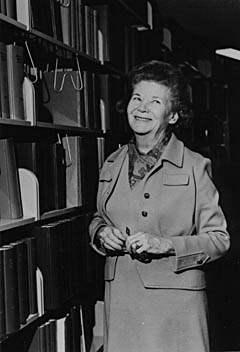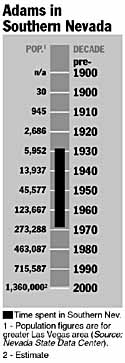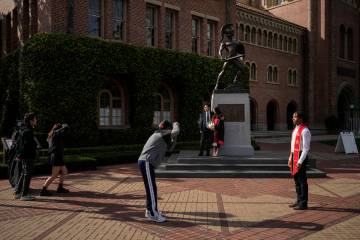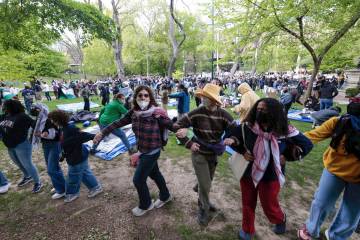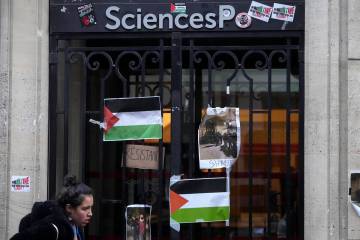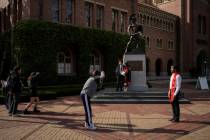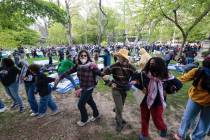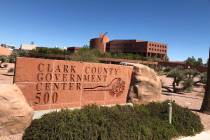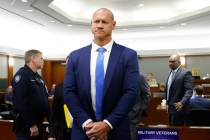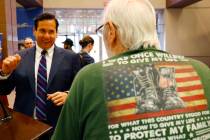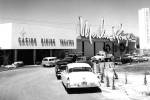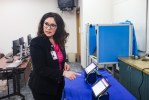Eva Adams
Eva Adams was from a town that doesn't even exist today, yet she became one of the most powerful women in Washington.
Her power came from her association with Sen. Pat McCarran, but what he got in return was the most effective staff in the Senate building.
Adams was a pint-sized 5-foot-1 with her hair up. But she had brains enough for two, and they served her well as a teacher at Las Vegas High School and the University of Nevada, director of McCarran's Washington office, and director of the U.S. Mint.
Because she was pretty and never married, she was rumored to be McCarran's mistress. But she denied it to a journalist in 1989, when she was 79 years old and most who cared were already dead. "They said that I visited Senator McCarran ... and that the place was full of cigarettes with lipstick on them. Now, that alone should have exonerated me because I didn't know how to smoke."
Adams was born in 1910 in Wonder, a mining camp in Churchill County, east of Fallon. Her father worked for the mining magnate George Wingfield. "When Mr. Wingfield started a camp, he would send my father to set up the hotel and the commissary, the bar, and such things as that," she explained to Mary Ellen Glass, an oral historian, for the University of Nevada, Reno. "So we would go and stay until it was running well and then if Mr. Wingfield ... had started another mine, my father would have to go. So we lived in many places."
Picking up and moving throughout her childhood, she said, taught her independence, the ability to make friends quickly, and to be happy wherever she was.
The one-room schoolhouses of mining camps enabled her to advance at her own pace, so when she entered high school in Reno, she was ahead of her peers. "I had an inferiority complex, of course, because of being fat. But ... I was too busy to brood. ... I was in every sport ... and I've often wondered because I couldn't run fast, but I think it was my enthusiasm." She graduated from high school at 14.
Adams won a scholarship to Vassar, but that campus was too far away and too expensive. She stayed in Reno to attend the University of Nevada, and despite her scholastic bent, said the most important thing that happened to her there was being accepted by a good sorority. "I don't like the feeling that they are so exclusive that they hurt students who don't make it ... but for a self-conscious youngster like me, the encouragement of those girls ... and the pride they had in me ... I wouldn't have gotten a bad grade for anything in the world, mostly because the Thetas wouldn't like it."
By the age of 19 she was teaching at Las Vegas High School. "Many of the students worked on the railroad, and sometimes they would drop out," she told Glass. "They would work for two or three years -- before they went to high school, mind you. ... So I encountered probably as tough and difficult a group of young people as you ever saw. ... One young fellow ... stood in the study hall and he wouldn't behave, and he had a basketball and he just threw it at me. And I picked that thing up and I threw it back at him and hit him right in the nose ... never had trouble with him after that."
Adams became so annoyed with the makeshift city library, which had no record of which books it had, that she got some Camp Fire Girls to create the library's first index.
It was in Las Vegas, through her landlady, that Adams began socializing with people like political kingmaker Al Cahlan and his wife Ruth, and with Ed Clark, who ran the Clark County Democratic Party. She met Pat McCarran on a holiday journey home, when a snowstorm stranded about 40 motorists at the Goldfield Hotel. "He came in and he bought drinks for everybody, and he wasn't running, and I thought what a nice man."
Adams attended graduate school at Columbia University and was teaching in the English department at the University of Nevada in 1940, when McCarran hired her to work in his Washington office. She shortly found herself in charge and had the good fortune to learn, very soon, how far she could go.
"The secretary of the Senate had an open bar, which created problems, frequently, and this night it was a great problem, because Senator McCarran had been at this open bar. He came stomping into the office." McCarran then dictated a number of exceedingly rude telegrams to some of the most important people in the aviation industry, ordering them to be in his office at 10 a.m. the following morning.
She stared at the telegrams, decided not to send them, and cleaned out her desk for her pending discharge from McCarran's employment.
McCarran didn't even show up till 10:30, about half an hour late for his meeting with the bigwigs. Later in the day he seemed to recall having ordered something, and she showed him the telegrams.
"My god, did you send those?" gasped the senator.
"No, and I'm resigning," said Adams.
McCarran laughed. "You don't have to resign, and thank you for not sending them," he said.
Thus they established a relationship by which Adams and her staff would quietly protect McCarran from his worst character traits and let his best shine. They were authorized to answer letters in his name, and the only time he ever got mad at something over his name turned out to be one of the few times he had signed his name himself.
McCarran's office developed a reputation as the most efficient in the Senate building. The Department of Agriculture, which for some reason assigned itself the job of teaching people how to run a senator's office, asked Adams to teach the class. "To my utter astonishment, several senators came with their staffs. Margaret Chase Smith never missed a meeting." It was amazing, she thought, what neither senators nor their staffs knew.
Adams attended law school while working in McCarran's office, and passed bar exams in both Washington, D.C., and Nevada.
After McCarran's death in 1954, Adams managed the office for his successors, Ernest Brown and Alan Bible, until 1961, when the new president, Jack Kennedy, invited her to have lunch in the Senate cafeteria and, by the way, to run the U.S. Mint.
Bible had suggested Kennedy hire her for more than one reason. It would help to have a mint director who understood something about precious metals and the states that produced them. In addition, Bible and Adams did not get along well. Yet Bible couldn't fire somebody so famously competent; the best thing was to find a new use for her organizational abilities.
Adams soon found she would need them all: The mint was a disorganized mess. It was full of over-the-hill oddballs who did their jobs as they liked. Nobody had bothered to order new presses to deal with a looming coin shortage created by coin-operated machines and an economy surging back from the Eisenhower recession.
One can't just run out to the nearest hardware and buy a coin press, however. "We're the only ones who use them, so nobody makes them to sell to anybody who comes along, thank goodness." That meant machines ordered the day she recognized a need would have to be built to order, and would not strike a coin until many months later. So, under her encouragement mint workers modified existing machines to produce more coins with the same number of blows; they raided government arsenals for machines, originally designed for making jackets for rifle bullets, and turned those into coin presses. They even took the presses from the old Carson City Mint, still maintained in Nevada for their historical interest, and pressed them back into service.
Congress complicated the issue by ordering, almost simultaneously, that silver be taken out of coins. This was necessary, said Adams, because the price of silver, though it fluctuated, tended to stay higher than the face value of the coins. There was supposed to be almost an ounce of silver per dollar's worth of money, but the market price of silver was $1.29 an ounce. Adams saw no way to continue minting coins that were mostly silver, but felt the government should have found a way to back money with precious metal. She was overruled.
The mint began issuing "sandwich money" made of common metals. Once that happened, the older silver coins were bought and hoarded by collectors, survivalists and speculators who planned to melt down the silver for its commodity value. Silver coins disappeared from common circulation. The short-term result was that coins were in even shorter supply.
She resigned the U.S. Mint job in 1969, pressed out by Richard Nixon, who wanted the director's job for a Republican. She was hired by Mutual of Omaha to work in its Washington offices. Yet, after spending more of her life inside the Beltway than in her native Nevada, she ultimately retired to Reno, where she died in 1991 at the age of 80.
How much she had remained a Nevadan is evident in a story she revealed about herself long after the fact.
During all the furor over the sandwich money, she was repeatedly assured that the new coins would work fine in any coin-operated machine. But on one of her visits to Nevada, she smuggled along a quantity of the blanks from which the new coins would be made, and arranged to personally test them in slot machines.
Pat McCarran probably smiled his approval.
Part I: The Early Years
Part II: Resort Rising
Part III: A City In Full



